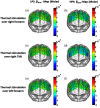Prefrontal hemodynamic mapping by functional near-infrared spectroscopy in response to thermal stimulations over three body sites
- PMID: 28018934
- PMCID: PMC5166717
- DOI: 10.1117/1.NPh.3.4.045008
Prefrontal hemodynamic mapping by functional near-infrared spectroscopy in response to thermal stimulations over three body sites
Abstract
Functional near-infrared spectroscopy (fNIRS) was used to examine hemodynamic responses in the prefrontal cortex (PFC) during noxious thermal pain, induced by thermal stimulations over three different body sites over the right forearm, right temporomandibular joint, and left forearm. Functional NIRS measurements were obtained from three groups of healthy volunteers, one group for each body region. Each group was subjected to both low-pain stimulation (LPS) and high-pain stimulation (HPS) by a [Formula: see text] thermode of a temperature-controlled thermal stimulator over the respective three body sites. Our results showed that HPS given at three sites induced significant increases ([Formula: see text]) in oxy-hemoglobin concentration ([Formula: see text]) in the PFC with similar temporal patterns in relatively spread PFC areas. In contrast, LPS did not cause any significant [Formula: see text] in the PFC of any subject group. Our observed PFC activations induced by acute HPS were generally consistent with previous reports by fMRI studies. The study also found a peculiar global trend of postpain deactivation in the PFC, which is attributed to global vasoconstriction due to acute nocuous pain. Overall, these results indicate that hemodynamic activities in PFC exhibit consistent temporal and spatial patterns in response to acute thermal stimulation given across all three body sites.
Keywords: functional near-infrared spectroscopy; innocuous pain; noxious pain; prefrontal hemodynamic mapping; thermal stimulations.
Figures











Similar articles
-
A semi-immersive virtual reality incremental swing balance task activates prefrontal cortex: a functional near-infrared spectroscopy study.Neuroimage. 2014 Jan 15;85 Pt 1:451-60. doi: 10.1016/j.neuroimage.2013.05.031. Epub 2013 May 17. Neuroimage. 2014. PMID: 23684867
-
Hemodynamic response to repeated noxious cold pressor tests measured by functional near infrared spectroscopy on forehead.Ann Biomed Eng. 2013 Feb;41(2):223-37. doi: 10.1007/s10439-012-0642-0. Epub 2012 Sep 7. Ann Biomed Eng. 2013. PMID: 22956158
-
Reduced prefrontal-temporal cortical activation during verbal fluency task in obsessive-compulsive disorder: A multi-channel near-infrared spectroscopy study.J Psychiatr Res. 2019 Feb;109:33-40. doi: 10.1016/j.jpsychires.2018.11.006. Epub 2018 Nov 8. J Psychiatr Res. 2019. PMID: 30468975
-
Functional connectivity of the human insular cortex during noxious and innocuous thermal stimulation.Neuroimage. 2011 Jan 15;54(2):1324-35. doi: 10.1016/j.neuroimage.2010.09.012. Epub 2010 Sep 19. Neuroimage. 2011. PMID: 20851770
-
Delta-9-tetrahydrocannabinol intoxication is associated with increased prefrontal activation as assessed with functional near-infrared spectroscopy: A report of a potential biomarker of intoxication.Neuroimage. 2019 Aug 15;197:575-585. doi: 10.1016/j.neuroimage.2019.05.012. Epub 2019 May 7. Neuroimage. 2019. PMID: 31075393 Free PMC article. Clinical Trial.
Cited by
-
Mapping cortical network effects of fatigue during a handgrip task by functional near-infrared spectroscopy in physically active and inactive subjects.Neurophotonics. 2019 Oct;6(4):045011. doi: 10.1117/1.NPh.6.4.045011. Epub 2019 Dec 10. Neurophotonics. 2019. PMID: 31853458 Free PMC article.
-
Longitudinal effect of transcranial direct current stimulation on knee osteoarthritis patients measured by functional infrared spectroscopy: a pilot study.Neurophotonics. 2020 Apr;7(2):025004. doi: 10.1117/1.NPh.7.2.025004. Epub 2020 May 7. Neurophotonics. 2020. PMID: 32411812 Free PMC article.
-
A study based on functional near-infrared spectroscopy: Cortical responses to music interventions in patients with myofascial pain syndrome.Front Hum Neurosci. 2023 Jan 27;17:1119098. doi: 10.3389/fnhum.2023.1119098. eCollection 2023. Front Hum Neurosci. 2023. PMID: 36778036 Free PMC article.
-
Contralateral cerebral hemoglobin oxygen saturation changes in patients undergoing thoracotomy with general anesthesia with or without paravertebral block: a randomized controlled trial.J Anesth. 2017 Dec;31(6):829-836. doi: 10.1007/s00540-017-2402-7. Epub 2017 Aug 23. J Anesth. 2017. PMID: 28836009 Clinical Trial.
-
Using prerecorded hemodynamic response functions in detecting prefrontal pain response: a functional near-infrared spectroscopy study.Neurophotonics. 2018 Jan;5(1):011018. doi: 10.1117/1.NPh.5.1.011018. Epub 2017 Oct 16. Neurophotonics. 2018. PMID: 29057285 Free PMC article.
References
LinkOut - more resources
Full Text Sources
Other Literature Sources
Miscellaneous

